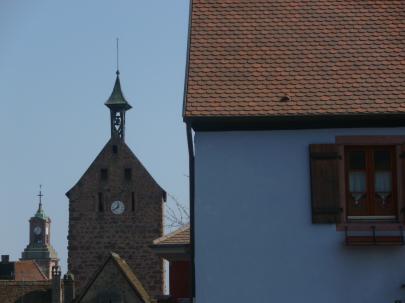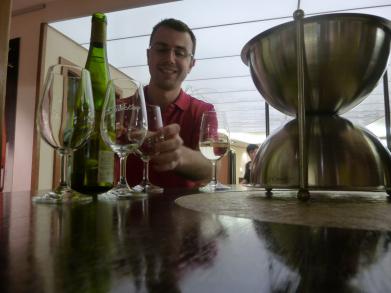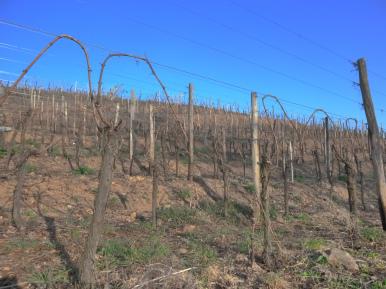
Clocktowers in Riquewihr
One of the greatest thrills that comes from traveling to an unknown place is how acutely our senses are sharpened. We’re more aware of what’s around us, what we see, hear, and smell, and also of where we come from. Many of us, when travelling, naturally associate the sights and sounds of the new locale to something familiar. These observations tend to be highly subjective and subtle; for example, if the light hits the trees just right, or if the buildings are lined up in the street a certain way, we can have a sensation of déjà vu. I don’t know if we subconsciously seek out these connections; maybe some more than others, but I know that it’s happened to me a few times. One of the least expected moments was when I was driving with my husband, then boyfriend, to Bordeaux. We exited the highway and were approaching the St. Emilion wine appellation, and all of a sudden I experienced this strange feeling of familiarity. The clouds hung low, the landscape was flat, the air felt humid, and there were towering pine trees everywhere I looked. I told Julien ‘You won’t believe this, but Bordeaux reminds me of Houston.’ I repeated in my head what I just said, and giggled to myself because the highest regarded wine region in the world reminds me of my gritty, beloved hometown. Julien, who hadn’t yet been to Houston, probably thought I was homesick.

J.B. leading a tasting
Recently, we took another road trip to another well-respected French wine region, Alsace, to visit our friend J.B. who works as the export manager for Cave de Turckheim. Because I’ve been on a white wine kick for a few years now, and an Alsatian Riesling ranks as my ‘desert island wine’ (the wine I’d want with me if stranded on a desert island), this trip was loaded with gustatory anticipation.
I’d been to Strasbourg years before, but it was my first time in the nearby wine region, and its long history with Germany was apparent through the architecture, the accent, and the cuisine. As a reflex, I mentally continued to make references to places I’ve been to before, but happily my palate-to-brain connection didn’t deceive me. I was comforted in knowing that my taste buds’ time-space continuum was aligned and the wines I had over the weekend tasted like Alsace: clean, bright, and aromatic.
White wine reigns there, notably the four noble grapes: Riesling, Gewurtztraminer, Pinot Gris, and Muscat, and for several years, this winegrowing area has been one of my favorites. Alsatian wines are, to me, a symbol of quality and consistency- most of the wine production is AOC, in fact, vin de pays doesn’t even exist there. Of the 10 white varietals (counting gewurtz, which is technically a red grape) we can find there, Riesling is the most planted and widely known. Because of the 1980′s influx of low-cost, sugary Rieslings in the US, it’s a common misconception to link all Rieslings with sweetness and cheap blue bottles- most from Alsace are dry and euphemistically uncheap. At best, an Alsatian Riesling is crisp, has a slight petrol (yes, I mean petrol) aroma, balanced acidity, green apple flavors, and a long finish.

Heart-shaped vines are typical in Alsatian vineyards
It’s not only Rieslings that do so well in the region; Pinot Gris (aka Tokay), Sylvaner, and Gewurtztraminer all excel there. As important as terroir is in any wine country, geography and geology play a big role in Alsace’s white winegrowing success: the Vosges mountains to the west protect the vines from freezing temperatures while maximizing exposure to the sun. Limestone, schist, gneiss, and pink granite are just a few of the multitude of soil types that provide unique characteristics to the individual grape varieties. Red wine does exist there, Pinot Noir plantings only consist of 10%% of the total vineyard area, and with good reason. Most that I’ve tried have been unpleasant, tasting off-balanced and even burnt, so I’d recommend sticking to the what put Alsace on the map, their white wines.
Like the elegantly manicured gardens and vineyards you’ll find in this idyllic region, the best expressions of the local wines are clean, refined, and graceful. The scenery may remind you of Switzerland, the food may remind you of Germany, but the wine, I can assure you, will be just like Alsace.
